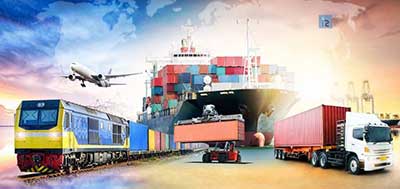Relevance: GS-3: Infrastructure: Energy, Ports, Roads, Airports, Railways, etc.
Key Phrases: Global Manufacturing Risk Index, One Nation One Tax, Goods and Services Tax (GST), logistics sector, E-Way Bill, Supply Chain Management, ‘Just in time’ operations, ‘Make in India’ initiative, Integrated Supply Chains.
Why in News?
- Five years after the GST roll-out, it can be said that India has truly benefited from this game-changing implementation of “One nation one Tax”.
- India has replaced the United States as the second-most favourable manufacturing hub, according to Cushman & Wakefield’s 2021 Global Manufacturing Risk Index.
Global Manufacturing Risk Index 2021
- It is released by the US-based property consultant Cushman & Wakefield.
- It assesses the most advantageous locations for global manufacturing among 47 countries in Europe, the Americas, and Asia-Pacific (APAC).
- In the Global Manufacturing Risk Index 2021, India became the second most sought-after manufacturing destination globally, driven mainly by cost competitiveness.
Benefits of GST implementation:
- The Goods and Services Tax (GST) has not only unified the country into one common economic market but has also resolved frictions between states by building a tightly interlocking system between buyers and sellers.
- The use of technology and transparency has resulted in high compliance and minimal leakage.
- The monthly gross GST collections have crossed ₹1 trillion and this revenue buoyancy augurs well for the country and its economy.
Benefits of GST to the logistics sector:
- The logistics sector has been a major beneficiary of GST, as observed over the past five years.
- Seamless transportation:
- First, seamless transportation reforms have resulted in the faster movement and turnaround of products (a reduction of at least 12% to 15% in transport time between major cities and in some cases as much as 30% to 40%).
- E-Way Bill:
- Second, the introduction of the e-way bill has facilitated and
streamlined supply chain management for most companies.
- The usage of e-way bills has almost made it necessary for users and players in the logistics sector to further develop digital technology capabilities.
- This will also assist in building leaner supply chains and achieving better capacity utilization.
- This process can be speeded up to the benefit of India’s manufacturing sector by GST being coupled with the Centre’s Gati Shakti initiative of integrating six different ministries digitally aimed at providing users with online information.
- Second, the introduction of the e-way bill has facilitated and
streamlined supply chain management for most companies.
- Eased out synchronization between buyer and seller
- With the implementation of the Goods and Service tax the logistics industry started exploring new innovations for their supply chain models and helped in building a better customer-seller relationship.
The manufacturing sector and Logistics sector:
- Logistics service providers have become part of manufacturing supply chains.
- The success of the ‘Make in India’ initiative, which was launched a few years ago, is driving the growth of the manufacturing sector, which contributes around 15% to our gross domestic product.
- It is estimated that for each percentage-point rise in manufacturing sector output, the logistics and supply chain industry have to grow one-and-a-half times as much.
- Further, GST has enabled multiple layers of sub-component manufacturers to become part of integrated supply chains.
- Similarly, on the consumer side, retailers and distributors have a level playing field, due to the alignment of set-off tax credits.
- A significant benefit for both the manufacturing and logistics sectors is the ability to now optimize a supply chain, whether it be warehousing or transport planning, and link it with sales planning to enable quick delivery to consumption points.
- This can be done now on a real-time basis through the use of technology, and most importantly, without having to bother about tax-based allocation efficiency.
Role of technology:
- ‘Just in time’ operations have become a reality in India, as in the developed world.
- Logistics companies have benefited, as the usage of technology has reduced cash flow cycles, making finance management a lot easier.
- There is the complete integration of processes that involve manufacturers, logistics service providers, and consumers.
- GST has removed any need for re-engineering supply chains for tax arbitrage and management.
- Outsourcing:
- The use of technology has also resulted in an awareness of the need to outsource more and more services to enable companies to focus on their core competencies while leveraging the capacity and capability of integrated logistics providers.
- The government’s production-linked incentive (PLI) scheme and export thrust are further catalysts of this.
- The rise of third-party integrated logistics service providers has helped small transport operators ally with them and grow.
- India’s special advantage of having livelihood businesses in the transport sector has been harnessed by this win-win partnership.
Employment generation:
- The organization of the logistics sector has led to more than 40 million people being employed by it, as against 22 million five years ago (in the pre-GST era).
- This kind of robust growth will be enhanced by more outsourcing, which would lead to more jobs being generated by this sector.
Conclusion:
- What mobile technology did to the country’s communication sector has happened to Indian supply chains and the logistics sector, due to GST.
- The entire sector has begun to enjoy the benefits of this tax regime, and its growth over the next few years is expected to result in multiple benefits for the country.
- The logistics sector will always see the introduction of GST and e-way bills as the inflection point that catapulted it ahead.
Source: Live-Mint
Mains Question:
Q. India’s logistics sector has benefited from the game-changing implementation of Goods and Service Tax. Discuss.








